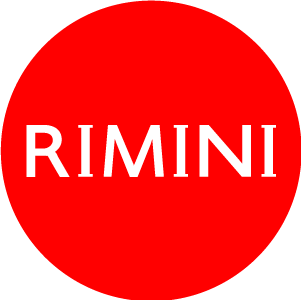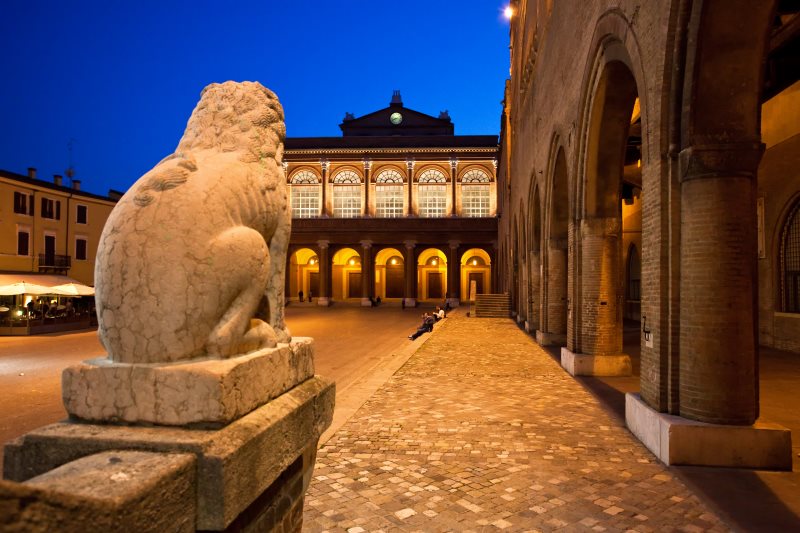
Guida pratica
Rimini
Rimini is a city in the Emilia-Romagna region located on the Adriatic coast.
Everybody knows it as it is one of the most famous tourist destinations throughout Europe. It has a long tourist tradition – the first Italian bathing estabilishment was opened on the shore of Rimini back in 1843.
Since then, this propensity to hospitality has spread all along the Rimini Riviera, from Riccione to Cattolica, from Bellaria to Misano. Its popularity lies in its 250 bathing estabilishments (which in recent years are being renewed thanks to the major redevelopment project of the promenades, the 'Parco del Mare'), over one thousand hotels overlooking the sea (including the Grand Hotel dear to Fellini, design hotels but also boarding houses), theme parks, many opportunities to have fun and to taste delicious food – from piadina street food stalls to exclusive restaurants.
In Italy, this city stands out for its hospitality and welcoming culture. A rich and vibrant landscape that has been a source of inspiration for film directors, intellectuals, writers, singers such as Fred Buscaglione, Fabrizio De André, Ligabue, Pier Vittorio Tondelli, and the genius Federico Fellini, the one that most successfully honoured his birthplace as a sign of universal poetry.
MORE THAN TWO THOUSEND YEARS OF HISTORY
Yet Rimini, the ancient Ariminum, is also and mainly a city of art with over 22 centuries of history. A unique and incomparable heritage, a piece of Italian art history enclosed in an area of only a few thousand squared metres. This can be seen in the standing monuments of the Amphitheater and the surgeon's House, Domus del Chirurgo, the most important archeological remains with an extensive collection of ancient surgery tools, the only one of its kind in Italy – a tiny Pompei in the heart of Rimini. It can also be seen in the Arch of Augustus, end of Via Flaminia, or in Tiberius Bridge, beginning of Via Emilia as well as Via Popilia. At the start of the 14th century, Rimini saw the establishment of a Giotto’s painting school which enshrines an essential chapter of Italian art history. Many works of that period are preserved in the church of Sant’Agostino and in the Civic Museum. Among them, is the last judgment by Giovanni da Rimini, the most wellknown artist in this school inspired by Giotto, and the crucifix by Leon Battista Alberti in the Malatesta Temple.
Furthermore, Rimini was the land of Sigismondo Malatesta, who commissioned two of the most extraordinary examples of the Italian Renaissance – the above mentioned Malatesta Temple and Sismondo Castle, by Filippo Brunelleschi.
Rimini also hosts Amintore Galli Theatre, neoclassical masterpiece by Luigi Poletti, inaugurated by Giuseppe Verdi with the Aroldo opera in 1857. This theatre is one of the most significant pieces of the 19th-century theatre architecture, damaged by bombing in 1943 and, after decades of disuse, thanks to recent restoration works, it reopened to the public in October 2018 with great performances. A kernel of beauty that the city has been recovering and enhancing.
Speaking of Fellini, Cinema Fulgor also reopened in 2018, on the date (20 January) when Federico Fellini would have turned 98. The cinema, which he used to visit with his father as a child, is a unique movie theater, masterfully designed by Academy Award winning art director Dante Ferretti.
A concentration of beauty that the city has been recovering and enhancing for some years and that in 2021 is completed by the inauguration of the Fellini Museum, a brand new museum spread over three spaces - Sismondo castle, Fulgor Plas and Piazza Malatesta, or the square of dreams. That is the largest museum project dedicated to the genius of Federico Fellini.
The city offers an array of events during the whole year, together with conferences and business meetings thanks to Rimini Fiera (one of the largest Italian trade fair centres) and the Palacongressi (one of the most modern convention centres in Italy).
THERMAL BATHS
If you intend to combine wellness with holidays, Riminiterme is the right place. A modern spa, overlooking a free beach in Miramare, that all year round offers relaxion and special therapies for bone and respiratory diseases, and beauty treatments including sauna, hot tubs, mud baths, massages and water aerobics. Indoors there is a gym as well as pools with sea water and a beautiful sea view.
THEME PARKS
Starting from the marvelous miniatures of architectural masterpieces at Italia in Miniatura to the magic of Merlin the Wizard in Fiabilandia, fun is guaranteed in theme parks along the Rimini Riviera. The other parks Oltremare, Aquafan and the Acquarium in Cattolica are also a must see.
THE DOCK
With the official ribbon cutting ceremony in 2002, the Marina di Rimini's new dock, located alongside the channel port, hosts 680 moorings, 90 cave à bateau covering a glassy water surface of 108,000 square metres. The entrance to the port is 55-metres wide and up to 5-metres deep, also enabling access to large boats.
UNIVERSITY
At the heart of the city centre is the Rimini campus of the University of Bologna, in via Angherà 22. The opening dates back to 1972 and today is a fully-fledge University that offers Bachelors and Master’s degrees with more than six thousand students coming from throughout Italy and abroad.
THE SURROUNDINGS
Not to be missed is a visit in the surrounding area with its natural resources, historical attractions as well as craftsmanship and food tradition which add value to seaside holidays. The numerous castles and ancient churches standing on the surrounding hills are a tangible artistic and cultural heritage really worth visiting, from Santarcangelo to Verucchio and San Leo, from Saludecio to Mondaino in the stupendous valleys of the Conca and Marecchia rivers.
Rimini has a privileged location – a city by the sea and a junction of important communication routes.
From the North, there is a convenient straight 3-lane motorway, "Autostrada del mare" A 14, including two exits at the tollgates of Rimini Nord and Rimini Sud. The northen exit, Rimini Nord, leads to an area between Torre Pedrera and Santarcangelo, heading towards the coast you come across tourist towns that make up Rimini’s Riviera, such as Torre Pedrera, Viserbella, Viserba, Rivabella and San Giuliano Mare. On the contrary, if you are heading to Marina Centro, Bellariva, Marebello, Rivazzurra and Miramare, you should take the southern exit, Rimini Sud, also a junction of the highway for the Republic of San Marino, SS 72. From the North-East, Veneto, Trentino, Friuli as well as Ferrara, you can take Via Romea and then Statale Adriatica, SS16, which connects Ravenna to Rimini. From the South, there are either the motorway Autostrada del Mare, connecting Bari to Rimini, or the highway SS 16, along the Adriatic coast. From Umbria or Tuscany, you can take the highway SS 258, Marecchiese, that after crossing the pass of Via Maggio goes down towards Rimini passing by the Valmarecchia valley.
You can get there by train easily too. Every train stops in Rimini and in the summer there are also more trains running. Additionally, Fellini Airport, in Miaramare, connects Rimini with European capitals. In the summer, the number of flights increases due to tourist low cost flights.
Distance from the main Italian cities:
Milan 332 km
Rome 339 km
Urbino 58 km
Ferrara 125 km
Modena 161 km
Florence 159 km
Perugia 169 km
Venice 214 km
Verona 241 km
Beaches:
Lenght: Km. 15
Minimun width: m. 40
Maximum width: m. 200
Accommodation service:
Hotels and boarding houses: 1,196
Beds: 62,000
First proved evidence of tourist bather in Rimini:
the 1st tourist bather in Rimini was the Irish Elisabeth Kenny in 1790
the 1st bathing establishment was Stabilimento Tintori Baldini opened in 1843
In 1872 the famous Kursaal was built and by this time Rimini had become a fashionable place full of glamour. Next to it, the hydrotherapy Institute was added in 1876
Villa Adriatica was the first hotel to open in 1896, while the Grand Hotel was inaugurated in 1908 (it had 200 rooms). Todays it is a national monument.

©2016-2023 Assessorato al turismo / Comune di Rimini, Piazzale Fellini 3 47921 - Rimini - +39 0541 704587 / Ufficio Informazioni Turistiche (IAT) +39 0541 53399 / fax +39 0541 56598 / Statistiche web


